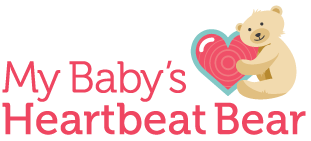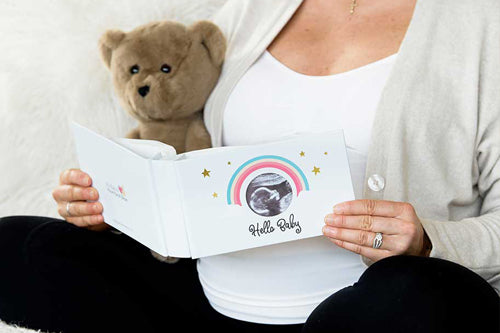Baby’s First Foods

I remember counting down the days until my first baby was 6 months old. I was staying at home, taking approximately 236 pictures of my amazing infant per day, and could not wait to introduce a new element into our daily lives: REAL FOOD.
As you all know, we at My Baby's Heartbeat Bear are huge breastfeeding advocates! We believe (and research shows) that breastmilk is the best source of nutrients for babies up until at least a year of age, and exclusively for the first 6-9 months. But once your baby shows an interest in food and is at least 6 months of age, there's nothing wrong with setting out the sampling tray!
Before the First Bite
Are there any food allergies in the family? If so, table those foods for much later.
Know what a food reaction, allergy or sensitivity looks like
Go slowly with introducing foods. Every baby will have an individual response to each food. Introduce new foods one at a time and continue to feed that same food for three to four days to rule out the chance of a reaction. Signs of intolerance are redness around the mouth, coughing, vomiting, abdominal bloating, irregular gas, irritability and abnormal crankiness, over-activity, change in sleep, constipation or diarrhea, nasal congestion, eczema-type skin irritation anywhere on the body, and a red ring around the anus. A reaction can include one or many of these symptoms, and the food should be avoided until the gut is stronger and can be tested again.
Let’s talk food options and reasons behind them.
Remember that food before one is only for fun; however, you do not want to give food as a filler. Making nutritious choices goes far beyond keeping baby healthy, but it can increase brain health, boost the immune system, encourage an optimal nervous system, build a healthy gut, and provide the foundation of a lifetime of healthy food choices. (I highly recommend reading The Nourishing Traditions Book of baby and Child Care to educate yourself on how to help grow your child in the healthiest manner.)
Great First Food Options
Avocado. Creamy, fatty (monounsaturated – the good kind of fat), vitamin-filled goodness.
Bananas. Calcium. magnesium, potassium, and electrolytes!
Carrots. Easier to digest than greens and other vegetables, these sweet treats are loaded with vitamin A, beta-carotene, and so many other vitamins and minerals.
Pears. Vitamin C, Vitamin K and delicious. Pears are the least acidic fruit.
Squash. A source of carbohydrate loaded with vitamins, they are easy to digest and do not contain more complex polysaccharides found in starchier foods.
Bone Broth. An immune boosting, brain supporting digestive restorative that helps the lining of the digestive tract mature and strengthen. Introducing real bone broth prepares baby’s tummy to digest more complicated foods down the road.
Egg Yolk. The yolk alone is recommended as a wonderful first food to support brain development, immune system and nervous system maturation. Making sure the egg yolk is from a local, trusted source is a wise choice (as with all of your food). The egg white should not be given until after a year of age.
Sweet Potato. A sweet complex carbohydrate loaded with vitamin A, vitamin C, B6, Potassium, Manganese, Magnesium, Iron, and vitamin E.
Beets. Supporting liver function and digestion, they help clean the blood.
Spinach. Vitamin A packed boost to the immune system. Baby’s eye sight, heart, and other organs all benefit from spinach.
Broccoli. Filled with vitamins A, K, Calcium, Potassium and Folate
Cauliflower. Wonderfully filled with Folate, Potassium, and Vitamin C Once you have tried several foods without issue, feel free to mix and match them to create delicious food combinations.
It is also believed that a baby’s earliest solid should be mostly animal foods since the digestive system is better equipped to supply the enzymes for digestion of fats and proteins rather than carbohydrates. (source)
Children need high levels of fat throughout growth and development. Healthy fats give energy and help build muscle and bone. Animal fats provide vitamins A and D necessary for protein and mineral assimilation, normal growth and hormone production. Including a range of stable saturated fats (such as real butter, meat, coconut oil) and monounsaturated fats (avocados and high quality olive oils) ensure your child is getting the quality fats he needs.
Preparing the Food
Soft foods such as avocados, bananas, pears, etc can be given raw and mashed with your fork. High pectin fruits such as peaches, apricots, apples, cherries, and berries should be cooked to break down the pectin. (These fruits are typically not introduced too early due to irritation of the digestive track.) Vegetables should be cooked (preferably steamed) and mashed, mixed with breastmilk or a liberal amount of fat such as real butter or coconut oil to aid in digestion. Meats should be cooked and pureed before served.
Quality of Food
Keep in mind that our food is not of the highest quality any more. Pesticides, herbicides, GMO’s, they are all harmful – especially to the tiniest of guts. Purchase local, organic foods, grass-fed meats, whenever possible.
Baby’s Digestive System
Please respect the tiny, still-developing digestive system of your baby. Babies have limited enzyme production, which is necessary for the digestion of foods. It can take up to 28 months for the carbohydrate enzymes to fully develop. Conveniently enough, this is the same time that the molar teeth are growing. Grains: cereals, wheats, breads, rice, oats, etc can be difficult to fully digest before this point, so they should be the very last foods introduced.
When is Baby Ready?
Learn your baby’s signals and signs. Babies will lean toward food and open their mouths. They need to be fully sitting unassisted and capable of swallowing while breathing. When ready to eat, infants will stop thrusting the tongue against a spoon or food when it is offered.
Can you Offer Water?
Water can be introduced at six months of age with foods, but is not needed. A sippy cup of breastmilk will do fine, but if you are not pumping, then feel free to offer sips of water at this age.
Foods to Avoid
Besides the above mentioned grains, avoid any known allergens, honey, nuts, seeds, processed foods, and juice.
Featured Articles
5 New Year's Desserts to Make With Kids





















